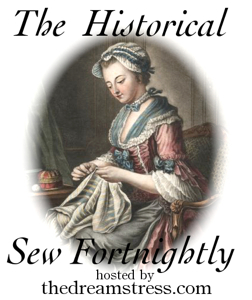
Challenge # 3 Under it All
Fabric: white cotton lining, cotton duct interlining, cotton sateen outer.
Pattern: Mantua Maker regency stays. I altered these slightly, cutting the neckline straight across instead of following the strange upward curve of the original pattern.
Year: 1800 -1825 the pattern said 1820 but these sort of stays where worn well into the middle of the 20's and even later depending on how fashionable the lady was.
Notions: Cotton bias tape, Gutermann's polyester thread, cable ties for boning and embroidery floss for the hand bound eyelets, wood busk.
How historically accurate is it? I would say 50-75% ,the look of the finished stays and the shape it gives the body are certainly period correct. The pattern seems authentic enough, and the fabric certainly is period, the binding and lacing eyelets where done by hand and the busk is made from wood like a period busk would have been. I did however machine sew most of it with polyester thread, and it is boned with cable ties.
Hours to complete: about 15
First worn: March 16th at the Pittsburgh Jane Austen Festival
Total cost: About $50, $61 if you count the pattern.
 |
| The finished stays on my dress form. |
 |
| Spiral laced back, it's not really crooked it was on the dress form crooked... |
 |
| detail showing some of the machine quilting I did on the front panel. You can also clearly see the wood busk in the busk pocket. |
The second challenge I manged to participate in was challenge number 6 Stripes. Easy enough really as O do make a lot of things with stripes and again I had just the thing already planned anyway.
I made a chemistte and detachable under sleeves to be worn with my green striped drop front gown. I also made a massive neck ruff to go with it, but since it is not made from a striped material it doesn't count for the challenge.
Challenge #6 Stripes:
Fabric: just over a yard of very fine white striped cotton gauze from William Booth Draper
 |
| Yummy striped cotton gauze. |
Pattern: Sense and Sensibility chemistte pattern from the regency underthings pattern collection for the chemisette, the sleeve pattern is my own.
Year: ca 1815 with the ruff but could really be worn from before 1800 up through the 1830's without the ruff or a different collar.
Notions: Gutermann's poly thread, silk bias tape for the neck binding, silk ribbon to tie the chemisette at neck and under bust.
How historically accurate is it? 75% all materials are period correct, all visible seams are and sewn but all inside and hidden seams are machine sewn with poly thread.
Hours to complete: About 2
First worn: March 16th 2013 at the Pittsburgh Jane Austen Festival. worn with a large double layered organdy neck ruff.
Total cost: Can't remember exactly what I paid for the fabric but it was a remnant and cost under $15. the silk ribbon and bias tape came from the stash.
 |
| Chemisette and ruff |
 |
| Chemistte side view showing the drawstring holding the bottom together |
 |
| The neck binding underneath the ruff, the ruff and chemisette tie shut at the throat with a drawstring. |
 |
| The chemistte ties closed underneath the bust with a drawstring |
 |
| Chemisette ruff and sleeves displayed with my striped drop front gown. |
 |
| Worn at the Pittsburgh Jane Austen festival |
So there you have it, my first 2 HSF ( Historical Sew Fortnightly ) challenges, I hope to be able to do more of them but with all my commission sewing and a tight schedule before doing a lot of travel this summer, I will have to see how many challenges I can squeeze in. Next up is the accessory challenge I'm sure I can whip up a quick hat or reticule on the side.




































